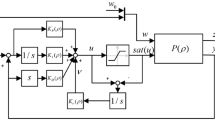Abstract
The present work is related to the design of the control surfaces actuation system that has been installed on a wind tunnel aeroelastic model within the GLAMOUR project. Such a scaled aircraft is equipped with two ailerons and an elevator, used to alleviate vertical gust loads. A control scheme, based on PID regulators, is taken into consideration, thanks to its simplicity. It was tuned through two different methodologies: an unfalsified frequency-based optimization and a Quantitative Feedback Theory (QFT) approach.
Numerical results are presented, comparing the adopted methodologies, considering both simple input signals and realistic command profiles.
Similar content being viewed by others
References
Sergio Ricci and al. Design and wind tunnel test validation of gust load alleviation systems. In 58th AIAA/ASCE/AHS/ASC Structures, Structural Dynamics, and Materials Conference, page 1818, 2017.
A. De Gaspari, S. Ricci, L. Riccobene, and A. Scotti. Active aeroelastic control over a mul-tisurface wing: Modeling and wind-tunnel testing. AIAA Journal, 47(9):1995–2010, 2009.
A. Mannarino. An adaptive compensation strategy of control surfaces free–play. In AIAA Guidance, Navigation, and Control Conference, pages 1–20, 2015.
Alessandro De Gaspari, Andrea Mannarino, and Paolo Mantegazza. A dual loop strategy for the design of a control surface actuation system with nonlinear limitations. Mechanical Systems and Signal Processing, 90(2017):334–349, 2017.
J. Tal. Two feedback loops are better than one. Machine Design. http://machinedesign.com/archive/two-feedback-loops-are-better-one, 1999.
M.C. Campi, L. Lecchini, and S.M. Savaresi. Virtual reference feedback tuning: a direct method for the design of feedback controllers. Automatica, 38(8):1337–1346, 2002.
S. Masuda, M. Kano, and Y. Yasuda. A fictitious reference iterative tuning method with simultaneous delay parameter tuning of the reference model. Proceedings of the IEEE International Conference on Networking, Sensing and Control, pages 422–427, 2009.
K. Levenberg. A method for the solution of certain non-linear problems in least squares. Quarterly of Applied Mathematics, 2:164–168, 1944.
D. Marquardt. An algorithm for least-squares estimation of nonlinear parameters. SIAM Journal of Numerical Analysis, 11(2):431–441, 1963.
T. Theodorsen and I. E. Garrick. Nonstationary flow about a wing-aileron-tab combination including aerodynamic balance. Technical report, NACA Technical Report No. 736, 1942.
M. Andrighettoni and P. Mantegazza. Multi-input/multi-output adaptive active flutter suppression for a wing model. Journal of Aircraft, 35(3):462–469, 1998.
F. Fonte, S. Ricci, and P. Mantegazza. Gust load alleviation for a regional aircraft through a static output feedback. Journal of Aircraft, pages 1–16, 2015.
C. D. Johnson. Accomodation of external disturbances in linear regulator and servomechanism problems. IEEE Transactions on Automatic Control, 16(6):635–644, 1971.
B. Friedland. Control System Design: An Introduction To State-Space Methods. Dover Publications, 2005.
I.M. Horowitz. Synthesis of feedback systems. Elsevier, 2013.
F. Toffol. Design of an aeroservoelastic wind tunnel model for gust load alleviation. Politecnico of Milano, Master Degree thesis, https://www.politesi.polimi.it/handle/10589/123166, 2016.
Author information
Authors and Affiliations
Rights and permissions
About this article
Cite this article
De Gaspari, A., Toffol, F., Mantegazza, P. et al. Optimal and robust design of a control surface actuation system within the GLAMOUR project. Aerotec. Missili Spaz. 95, 219–231 (2016). https://doi.org/10.1007/BF03404730
Published:
Issue Date:
DOI: https://doi.org/10.1007/BF03404730




